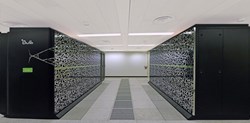ITER NEWSLINE
The contract for the supply of a high-performance supercomputer centre capable of performing complex plasma physics calculations has been signed between the Commissariat à l'Energie Atomique et aux Energies Alternatives (CEA) and Bull.
The supercomputer is an important part of Europe's contribution to the Broader Approach, an agreement signed between Europe and Japan to complement the ITER Project through various R&D activities in the field of nuclear fusion. European participation to the Broader Approach is coordinated by Fusion for Energy (F4E), the European Domestic Agency for ITER. This specific activity is provided by France as a part of its voluntary contribution to the Broader Approach.
The supercomputer will be located in Rokkasho, Japan, and will be available to a scientific community of more than 1,000 European and Japanese fusion researchers for the next five years starting from January 2012. With computational power above 1 Petaflop, the supercomputer will be ranked among the most powerful systems in the world, and at least ten times more powerful than any existing system dedicated to simulations in the field of fusion in Europe and Japan. The supercomputer, with a memory exceeding 280 TB and a high speed storage system exceeding 5 PB, will be complemented by a medium term storage system and a pre/post-processing and visualization system.
The operation of the supercomputer will begin with a few high-visibility code runs, otherwise known as "lighthouse projects" due to the light that they are expected to shed with their findings, to test drive the capacities of the supercomputer and achieve maximum performance. During the rest of its exploitation period, European and Japanese researchers will be invited to submit proposals which will be selected according to their importance for
the development of ITER and fusion research. The volume of findings stemming from this activity will feed into the plasma codes in preparation for ITER and into the design of the future DEMO reactor.
Click here to read the Press Release.
